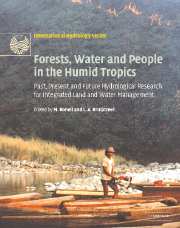 Forests, Water and People in the Humid Tropics
Forests, Water and People in the Humid Tropics Book contents
- Frontmatter
- Contents
- List of contributors
- Foreword
- Preface
- Acknowledgements
- Symposium and Workshop
- Introduction
- Part I Current trends and perspectives on people–land use–water issues
- 1 Trends and patterns of tropical land use change
- 2 The myth of efficiency through market economics: a biophysical analysis of tropical economies, especially with respect to energy, forests and water
- 3 Impacts of land cover change in the Brazilian Amazon: a resource manager's perspective
- 4 Forest people and changing tropical forestland use in tropical Asia
- 5 People in tropical forests: problem or solution?
- 6 Useful myths and intractable truths: the politics of the link between forests and water in Central America
- 7 Land use, hydrological function and economic valuation
- 8 Water resources management policy responses to land cover change in South East Asian river basins
- 9 Community-based hydrological and water quality assessments in Mindanao, Philippines
- Part II Hydrological processes in undisturbed forests
- Part III Forest disturbance, conversion and recovery
- Part IV New methods for evaluating effects of land-use change
- Part V Critical appraisals of best management practices
- Conclusion: Forests, water and people in the humid tropics: an emerging view
- Plate section
- References
7 - Land use, hydrological function and economic valuation
from Part I - Current trends and perspectives on people–land use–water issues
Published online by Cambridge University Press: 12 January 2010
- Frontmatter
- Contents
- List of contributors
- Foreword
- Preface
- Acknowledgements
- Symposium and Workshop
- Introduction
- Part I Current trends and perspectives on people–land use–water issues
- 1 Trends and patterns of tropical land use change
- 2 The myth of efficiency through market economics: a biophysical analysis of tropical economies, especially with respect to energy, forests and water
- 3 Impacts of land cover change in the Brazilian Amazon: a resource manager's perspective
- 4 Forest people and changing tropical forestland use in tropical Asia
- 5 People in tropical forests: problem or solution?
- 6 Useful myths and intractable truths: the politics of the link between forests and water in Central America
- 7 Land use, hydrological function and economic valuation
- 8 Water resources management policy responses to land cover change in South East Asian river basins
- 9 Community-based hydrological and water quality assessments in Mindanao, Philippines
- Part II Hydrological processes in undisturbed forests
- Part III Forest disturbance, conversion and recovery
- Part IV New methods for evaluating effects of land-use change
- Part V Critical appraisals of best management practices
- Conclusion: Forests, water and people in the humid tropics: an emerging view
- Plate section
- References
Summary
INTRODUCTION
Land use change affects economic activity both directly and indirectly. In the process of land colonisation that accompanies economic development and population growth, naturally occurring vegetation is typically affected in one of three ways: (1) available biomass and species are harvested and then left to regenerate before harvesting again, (2) the vegetation is simplified (in terms of its biological diversity) in order to increase production from selected species or (3) the existing vegetation is largely removed to make way for the production of domesticated species, the installation of infrastructure or urbanisation. The direct, and desired, impact of land use change under these circumstances is to raise the economic productivity of the land unit. Of course, many indirect (and perhaps unintentional) environmental impacts result as well. These impacts reflect the economic values attributed to natural vegetation and biogeophysical processes. Conversely, efforts to recuperate degraded lands or to protect natural ecosystems may forsake direct productive benefits in favour of fostering these indirect environmental values.
The loss of biodiversity and alteration of ecological processes accompanying the logging and conversion of forestland have captured the public imagination in the 1990s, with corresponding growth in research aimed at illustrating these indirect ecological and economic impacts (Perrings et al., 1992; Barbier et al., 1994). This chapter concerns itself with another type of environmental value: the impact of land use change on the hydrological cycle.
- Type
- Chapter
- Information
- Forests, Water and People in the Humid TropicsPast, Present and Future Hydrological Research for Integrated Land and Water Management, pp. 99 - 120Publisher: Cambridge University PressPrint publication year: 2005
References
- 9
- Cited by


